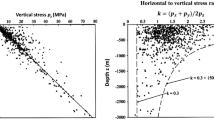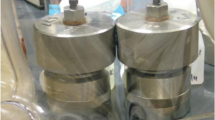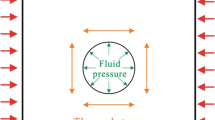Abstract
Flooded mines are a groundwater reservoir that can be used geothermally. Modelling such a reservoir can be complicated because it is necessary to simultaneously solve the equations of flow and heat transport within the mine voids and the surrounding medium, whose hydraulic parameters may have been affected by mining. We present a numerical model developed for the reservoir formed by the Barredo and Figaredo shafts in the Central Coal Basin of Asturias (Spain), using FEFLOW software. Both 2- and 3-D versions of the model were used to simulate the flooding of the mine. They were calibrated by comparing the results with actual water levels measured during flooding. The hydrogeological and thermal characteristics of the reservoir were adjusted to predict the long-term temperature of the water under different scenarios of water extraction and injection.
Zusammenfassung
Geflutete Bergwerke bilden ein Grundwasserreservoir, welches geothermisch genutzt werden kann. Die Modellierung solcher Speicher ist jedoch kompliziert, da bei der Simulation Fließ- und Wärmetransportgleichungen sowohl in den Grubenhohlräumen als auch in den umgebenden Gesteinen gemeinsam gelöst werden müssen, wobei die hydraulischen Parameter zudem durch den Bergbau beeinflusst sind. Es wird ein numerisches Modell präsentiert, welches für das Grundwasserreservoir der Bergbaufelder von Barredo und Figaredo im zentralen Kohlebecken von Astriuas (Spanien) entwickelt worden ist. Sowohl 2-D als auch 3-D Versionen der Software FEFLOW wurden verwendet, um die Flutung des Untertagebergbaus nachzubilden. Die Modelle wurden kalibriert, indem die Modellergebnisse mit aktuellen Wasserständen während der Flutung verglichen wurden. Die hydrogeologischen und geothermischen Parameter des Reservoirs wurden angepasst, um langzeitliche Temperaturentwicklungen im Wasser bei verschiedenen Entnahme- und Injektionsszenarien vorherzusagen.
Resumen
Las minas inundadas constituyen un embalse de agua subterránea, del que se puede hacer un aprovechamiento geotérmico. Modelizar este tipo de embalses puede resultar complejo, ya que es necesario resolver simultáneamente las ecuaciones de flujo y transporte de calor en los huecos mineros y el medio circundante, cuyos parámetros hidrogeológicos pueden haber resultado afectados por la actividad minera. Se presenta un modelo numérico desarrollado para el embalse constituido por los pozos mineros Barredo y Figaredo en la Cuenca Carbonífera Central de Asturias (España), por medio del software FEFLOW. Se realizaron versiones del modelo en 2 y 3 dimensiones para simular la inundación de la mina, que fueron calibradas comparando los resultados con los valores reales de nivel de agua medidos durante dicha inundación. Las características hidrogeológicas y térmicas del embalse fueron ajustadas para predecir la temperatura a largo plazo del agua bajo diferentes escenarios de extracción de agua y reinyección.
抽象
闭坑(或废弃)淹没矿坑可用作提供地热的地下水库。由于需要同时求解矿坑及周围介质的水力学和热力学方程以及方程水文地质参数受矿坑严重影响,地下水库的水力与热力学数值模拟比较复杂。利用 FEFLOW建立了西班牙阿斯图里亚斯地区(Asturias)中央聚煤盆地(Central Coal Basin)Barredo井与Figaredo竖的地下水库模型。同时利用二维和三维模型模拟了矿坑淹没过程,用矿坑淹没期间实际观测水位进行了模型识别。地下水库模型经水文地质学及热力学特征校正后用以预测不同抽水、注水情形下的水温长期预测。






Similar content being viewed by others
References
Álvarez J, Jardón S, Andrés C, Ordóñez A (2013) Valoración técnico-económica del aprovechamiento del agua de mina como recurso geotérmico mediante una red térmica de distribución en La Felguera, Asturias. In: Proc, Congreso sobre aspectos tecnológicos e hidrogeológicos de la geotermia, Barcelona, Spain
Bazargan-Sabet B, Demollin E, Van Bergermeer JJ (2008) Geothermal use of deep flooded mines. In: Proceedings of the post-mining symposium, Nancy, France
Blöcher MG, Zimmermann G, Moeck I, Brandt W, Hassanzadegan A, Magri F (2010) 3D numerical modelling of hydrothermal processes during the lifetime of a deep geothermal reservoir. Geofluids 10:406–421. doi:10.1111/j.1468-8123.2010.00284.x
Brigaud F, Chapman DS, Le Douoran S (1990) Estimating thermal conductivity in sedimentary basins using lithologic data and geophysical well logs. Am Assoc Petrol Geol Bull 74(9):1459–1477
Brown K, Trott S (2014) Groundwater flow models in open pit mining: can we do better? Mine Water Environ 33:187–190. doi:10.1007/s10230-014-0270-z
Clauser C, Heitfeld M, Rosner P, Sahl H, Schetelig K (2005) Beispiel Aachener Steinkohlenrevier—Nutzung von Erdwärme in aufgelassenen Bergwerken. Beratende Ing 6:14–17 (in German)
Diersch H-JG (2005) FEFLOW finite element subsurface flow and transport simulation system, reference manual. WASY, Institute for Water Resources Planning and Systems Research, Berlin
Dong D, Sun W, Xi S (2012) Optimization of mine drainage capacity using FEFLOW for the no. 14 seam of China’s Linnancang coal mine. Mine Water Environ 31:353–360. doi:10.1007/s10230-012-0205-5
European Commission (2002) Atlas of geothermal resources in Europe. In: Hurter S, Haenel R (eds) Publication no. EUR 17811, Luxembourg
Fandos P, Rodríguez F, Gutiérrez AM, Álvarez JJ (2004) El yacimiento de Hunosa en la Cuenca Carbonífera Central. Unpublished report, Servicios de Geología del Caudal y del Nalón
García-Fuente PA (1996) Sistema experto de predicción de desagües en minas subterráneas de carbón. Aplicación al Grupo Aller de HUNOSA. Ph.D. thesis, University of Oviedo, Spain, unpubl (in Spanish)
García-Loygorri A, Ortuño G, Caride de Liñán C, Gervilla M, Greber CH, Feys R (1971) El Carbonífero de la Cuenca Central Asturiana. Trabajos de Geología Univ de Oviedo 3:101–150
GEOELEC (Geothermal Potential for Electricity Generation for the EU-27) (2015) Surface heat flow and temperature maps. http://www.thermogis.nl/geoelec/ThermoGIS_GEOELEC.html
Ghoreishi SA, Ghomshei MM, Hassani FP, Abbasy F (2012) Sustainable heat extraction from abandoned mine tunnels: a numerical model. Renew Sustain Energy Rev 4(3):1–16. doi:10.1063/1.4712055
Hall A, Scott JA, Shang H (2011) Geothermal energy recovery from underground mines. Renew Sustain Energy Rev 15:916–924. doi:10.1016/j.rser.2010.11.007
Hamm V, Sabet BB (2010) Modelling of fluid flow and heat transfer to assess the geothermal potential of a flooded coal mine in Lorraine, France. Geothermics 39:177–186. doi:10.1016/j.geothermics.2010.03.004
Instituto Geológico y Minero de España (IGME) (1975) Mapa Geológico de España. MAGNA, Hoja 53. Memoria. Ministerio de Educación y Ciencia, Madrid
Jardón S (2010) Aprovechamiento de las aguas de mina en la Cuenca Central Asturiana como recurso energético. Aplicación al embalse minero Barredo–Figaredo. Ph.D. thesis (in Spanish)
Jardón S, Ordóñez A, Álvarez R, Cienfuegos P, Loredo J (2013) Mine water for energy and water supply in the Central Coal Basin of Asturias (Spain). Mine Water Environ 32:139–151. doi:10.1007/s10230-013-0224-x
Kranz K, Dillenardt J (2009) Mine water utilization for geothermal purposes in Freiberg, Germany: determination of hydrogeological and thermophysical rock parameters. Mine Water Environ 29:68–76. doi:10.1007/s10230-009-0094-4
Lawson DC, Sonderegger JL (1978) Geothermal data-base study—mine-water temperatures, vol 38. Special Publications, Montana Bureau of Mines and Geology, Montana, p 79
O’Sullivan J, Croucher A, O’Sullivan M, Stevenson L, Esberto M (2011) Modelling the evolution of a mine pit in a geothermal field at Lihir Island, Papua New Guinea. In: Proceedings of the New Zealand workshop
Ordóñez A, Jardón S, Álvarez R, Andrés C, Pendás F (2012) Hydrogeological definition and applicability of abandoned coal mines as water reservoirs. J Environ Monit 14:2127–2136. doi:10.1039/c2em11036a
Peralta E, Breede K, Falcone G (2015) Geothermal heat recovery from abandoned mines: a systematic review of projects implemented worldwide and a methodology for screening new projects. Environ Earth Sci 73:6783–6795. doi:10.1007/s12665-015-4285-y
Ramos EP, Falcone G (2013) Recovery of the geothermal energy stored in abandoned mines. In: Hou MZ, Xie H, Were P (eds) Clean energy systems in the subsurface: production, storage and conversion. Springer, Berlin, pp 143–155
Rapantova N, Grmela A, Vojtek D, Halir J, Michalek B (2007) Ground water flow modelling application in mining hydrology. Mine Water Environ 26(4):264–270. doi:10.1007/s10230-007-0017-1
Raymond J, Therrien R (2008) Low-temperature geothermal potential of flooded Gaspé mines, Québec, Canada. Geothermics 37(2):189–210. doi:10.1016/j.geothermics.2007.10.001
Raymond J, Therrien R, Gosselin L, Lefebvre R (2011) Numerical analysis of thermal response test with a groundwater flow and heat transfer model. Renew Energy 36(1):315–324. doi:10.1016/j.renene.2010.06.044
Renz A, Rühaak W, Schäzl P (2009) Numerical modelling of geothermal use mine water: challenges and examples. Mine Water Environ 28:2–14. doi:10.1007/s10230-008-0063-3
Uhlík J, Baier J (2012) Model evaluation of thermal energy potential of hydrogeological structures with flooded mines. Mine Water Environ 31:179–191. doi:10.1007/s10230-012-0186-4
Van Tongeren P, Dreesen R (2004) Residual space volumes in abandoned coal mines of the Belgian Campine basin and possibilities for use. Geol Belg 7(3–4):157–164
Verhoeven R, Willems E, Harcouet-Menou V, De Boever E, Hiddes L, Opt-Veld P, Demollin E (2014) Minewater 2.0 project in Heerlen the Netherlands: transformation of a geothermal mine water pilot project into a full scale hybrid sustainable energy infrastructure for heating and cooling. Energy Proc 46:58–67. doi:10.1016/j.egypro.2014.01.158
Watzlaf GR, Ackman TE (2006) Underground mine water for heating and cooling using geothermal heat pump systems. Mine Water Environ 25:1–14. doi:10.1007/s10230-006-0103-9
Wieber G, Pohl S (2008) Mine water: a source of geothermal energy—examples from the Rhenish Massif. In: Proceedings of the 10th International Mine Water Association Congress, Karlovy Vary, Czech Republic, pp 113–116
Wolkersdorfer C (2008) Water management at abandoned flooded underground mines: fundamentals, tracer test, modelling, water treatment. Springer, Heidelberg
Younger PL, Banwart SA, Hedin RS (2002) Mine water—hydrology, pollution, remediation. Kluwer, Dordrecht
Acknowledgments
The authors thank the HUNOSA company for providing valuable information, as well as DHI-WASY for their support regarding FEFLOW software. We are also very grateful to Dr. R. Kleinmann and Dr. C. Wolkersdorfer for their useful comments on an earlier version of the manuscript.
Author information
Authors and Affiliations
Corresponding author
Electronic supplementary material
Below is the link to the electronic supplementary material.
Rights and permissions
About this article
Cite this article
Andrés, C., Ordóñez, A. & Álvarez, R. Hydraulic and Thermal Modelling of an Underground Mining Reservoir. Mine Water Environ 36, 24–33 (2017). https://doi.org/10.1007/s10230-015-0365-1
Received:
Accepted:
Published:
Issue Date:
DOI: https://doi.org/10.1007/s10230-015-0365-1




